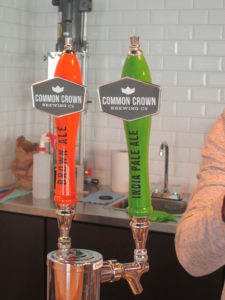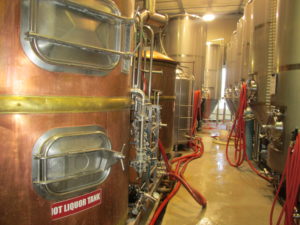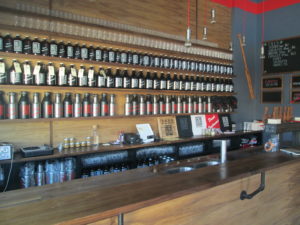Recently in the course of 24 hours I spent time talking to Calgary’s second oldest brewery and its two youngest. And I was amazed at how they were vastly different yet somehow similar.
The first day Brewsters’ co-owner Matt Lanigan generously spent a couple hours showing me around their main production brewery (which, oddly, I had never seen) and chatting about the brewery’s history and future. The next day I popped by both Common Crown Brewing and Highline Brewing to catch my first glimpse of their activities. The two new breweries opened within weeks of each other and are still feeling out the market.
I could likely write a post on each of the three visits separately but I am learning these days given my schedule that is an unlikely outcome. Besides it makes more sense to contemplate how the old and the new are related.
I learned a lot with my visit with Lanigan. Brewsters has seen a lot over the past 26 years. When they opened, the term “craft beer” had not yet been invented. They were truly tilling virgin land (along with Big Rock). I appreciate that Lanigan openly acknowledged that in the early days the beer quality “was up and down”, which – as an early customer – was certainly my experience. But they were feeling out what the beer consumer wanted (which was constantly in flux) and trying to create something original and fresh at the same time. It was early days for craft beer in Alberta.
 Today, Brewsters is often seen as conservative by many beer aficionados. Their flagship is their River City Raspberry Ale, followed closely by the blueberry ale. That might be a reason to disparage, but I disagree. To quote Lanigan, “you don’t pick your flagship, the consumer does.” That was the reality of when Brewsters got into business. The raspberry was the workhorse that allowed them to sell Blue Monk Barley Wine and many of their other more challenging seasonals over the years. The same reality faced Wild Rose, Alley Kat and other early entrants.
Today, Brewsters is often seen as conservative by many beer aficionados. Their flagship is their River City Raspberry Ale, followed closely by the blueberry ale. That might be a reason to disparage, but I disagree. To quote Lanigan, “you don’t pick your flagship, the consumer does.” That was the reality of when Brewsters got into business. The raspberry was the workhorse that allowed them to sell Blue Monk Barley Wine and many of their other more challenging seasonals over the years. The same reality faced Wild Rose, Alley Kat and other early entrants.
The contrast with today is not as stark as you might think. It is true that Common Crown, Highline and other new breweries don’t have to produce a fruit beer to survive. But it continues to be true that every brewery on the prairies needs an easy-drinking beer to appeal to a sizeable portion of consumers. Sure, they get to also experiment with bolder styles, but so has Brewsters over the years. I think over the last 20 years I have tried almost every beer style – save Lambic and other spontaneous fermented beer – at my local Brewsters pub.
It is easier for a brewery to brew “craft”-ier beer and make a living these days. But no brewery, at least not yet, can take their eye off of accessible and popular. Common Crown admits this reality. They have produced Brewmaster Blonde Ale that while they are quite proud of it, they admit is their gateway beer. They also have a quite good Coppersmith Brown Ale and a noticeable IPA, but, even as a new brewery, they recognize they have to have a foot on either side of the flavour divide.
And they are not alone. Look at any of the new Alberta breweries. Do they have an easy-to-drink offering? Yes. And that is not a bad thing.
Highline, which for the moment is mostly aiming to attract local neighbourhood customers, may be able to extend experimentation further, given their small volumes and local focus. So far they have been very adventurous, including making beer with Yerba Mate tea and playing with styles like creating a nitro-infused bitter stout. But even they know that they need something accessible, hence their burgeoning flagship, Common, a gentle ale that reminds me of a lower-IBU Steam Beer.
The three brewery visits were very different. Brewsters is well established and trying to expand their reach with Albertans, as well as maintain their reputation as a reliable go-to spot. Common Crown is new and delving into the heart of the craft beer industry by creating interesting beer to attract a range of beer drinkers. Highline is trying to develop a small-scale, artisan-created experience. Three very different breweries, but dealing with a very similar environment – meeting the needs of a mix of beer newbies and beer aficionados. Not an easy customer base to bridge.
Things may be more open for breweries today and the tough slogging of Brewsters’ early days may be gone, but that doesn’t mean it is easy sailing for a new brewery. They still need to find a way to produce a beer a wide range of people will like. And that reality is what brings the two generations together.
Let’s celebrate both the old and the new!



February 1, 2017 at 7:30 PM
If anyone is interested, the Brewsters 20 barrel brewhouse
in the above photo is for sale.
February 1, 2017 at 8:49 PM
That is, indeed, true. I am told it has been quite the workhorse over the past 20-some years. It ain’t pretty but it still can brew up a mean batch of beer.